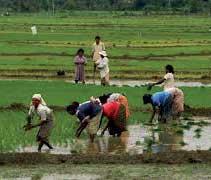21 Apr 2020 - {{hitsCtrl.values.hits}}
Sri Lanka’s agricultural sector is least affected by the economic shock triggered by the new coronavirus as the sector is loosely integrated with the global supply chains, compared to the industry and services sectors, ICRA Lanka, a unit of Moody’s, said in a new report. As lockdowns went into effect from mid-March to arrest the spread of the deadly virus, the government made agriculture a priority sector and listed it as an
essential service.

Through the ‘Saubagya’ scheme, home gardening of grains, vegetables and fruits has been encouraged to better equip the country to face the potential future crises such as pandemics and famines.
Although the country’s agricultural sector is not completely spared from the current crisis, as the pandemic has hurt a wider range of supply chains, the relative impact on the sector is trivial, compared to the heavy toll on the much-integrated industry and services sectors, ICRA Lanka said in a comprehensive study carried out into all three sectors of the economy during the previous two crises in the 2001 recession and 2019 Easter attacks.
“The performance of the agricultural sector generally gets affected by the vagaries of the weather. The outbreak of the COVID-19 virus is expected to affect the Sri Lankan agricultural sector to a certain extent, as a result of supply disruptions.
However, due to the loose integration with the global supply chains, this sector is expected to largely remain resilient,” the rating agency said.
“The government is also likely to intervene in ensuring there is an adequate supply of fertiliser coming into the country. In addition, the agricultural sector may benefit from the fall in the prices of agrochemicals, due to the low oil prices,” ICRA Lanka said adding that the supply chain disruptions might increase the scarcity of inputs, ultimately raising the
import prices.
ICRA Lanka’s report is an in-depth study into the current crisis and its toll on the economy and its various sectors, going as far back as the LTTE attack on the Central Bank in 1996 and 2001 economic contraction caused by the LTTE attack on Bandaranaike International Airport, which was compounded by a foreign exchange crisis triggered by a spike in oil prices and need for continuous importation of the military equipment, up to the most recent Easter attacks in 2019.
The rating agency estimated the pandemic’s economic toll to be no greater than a 2 percent contraction at its peak, in its base-case scenario, compared to the negative 14 percent shock on the industry sector and negative 7 percent shock on the services sector.
While the economic shock on the agriculture sector from the present crisis is a percentage point higher than the shock from the Easter attacks last year, the COVID-19 toll on the sector is similar to the shock in 2001, when the economy was contracted by 1.5 percent, ICRA Lanka’s estimates showed.
But even that time, the contraction of the sector and economy was largely attributed to the year-long drought than to the actual crisis that year.
In 2001, agriculture accounted for 20 percent of the economy while today, it accounts for 7 percent with 25 percent of the workforce concentrated into it.
In another study by Softlogic Capital last week forecast a renaissance in the agricultural sector during the ensuing decade with its share to the overall economy accentuating.
However, ICRA Lanka cautioned that the agricultural exports could experience a decline.
“This includes fisheries, which is exported as processed food under the industrial sector. However, the demand for commodities such as rubber may increase, driven by the heavy use of surgeons’ gloves, etc., which may benefit the sector.”
Although the tea prices are setting new records in the online auctions being conducted at present, the rating agency is cautious that the prolonged economic instabilities in the key markets could weigh on the prices in future.
Overall, ICRA Lanka expects the Sri Lankan economy to contract by 1.9 percent in 2020, with a U-shaped recovery, returning to the pre-crisis level by the first quarter of 2021.
“All alternative scenario simulations point to recessionary outcomes – an escalation of the pandemic leading to a severe L-shaped recession of -3.3 percent while the most optimistic estimations showing a mild V-shaped recession of -0.6 percent.”
The rating agency also warned of a possible increase in unemployment to upper single digits, before accelerating to double-digit levels, as before the late 1990s, should the crisis persist longer.
ICRA Lanka forecasts Sri Lanka’s fiscal deficit at 8.0 percent for 2020, with the inflation hovering in the range of 4.0 percent to 7.0 percent, as part of its base-case scenario.
17 Nov 2024 1 hours ago
17 Nov 2024 2 hours ago
17 Nov 2024 2 hours ago
17 Nov 2024 2 hours ago
17 Nov 2024 5 hours ago